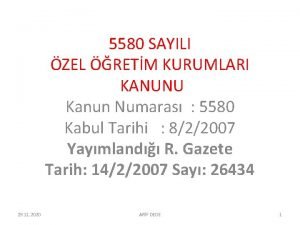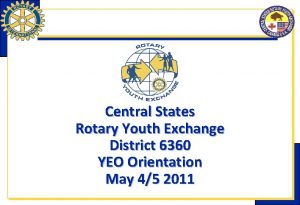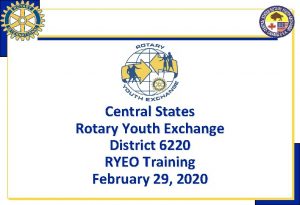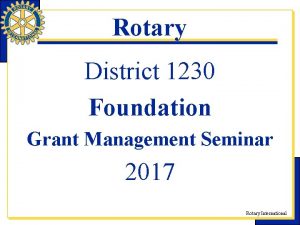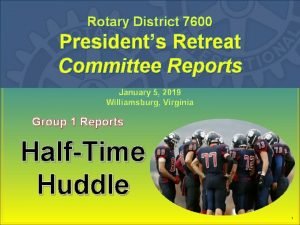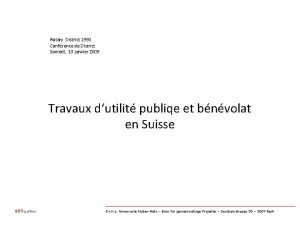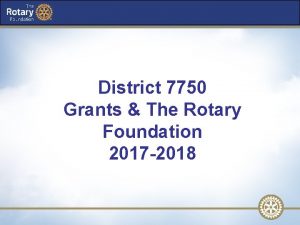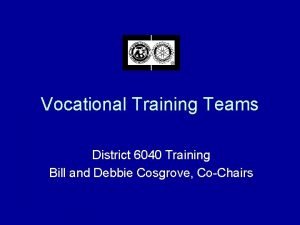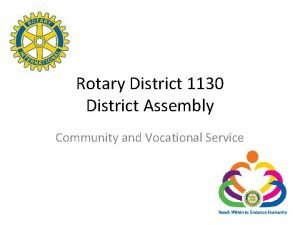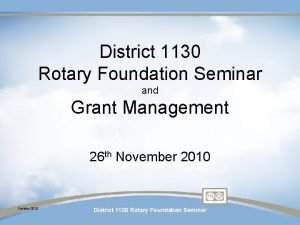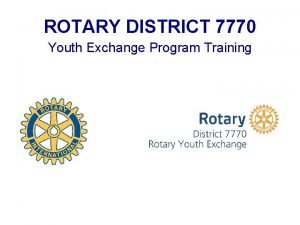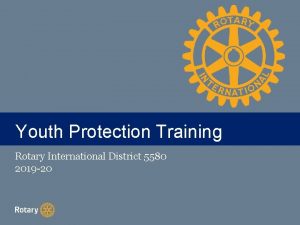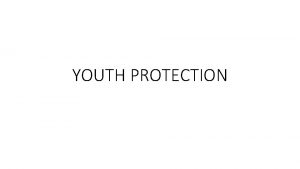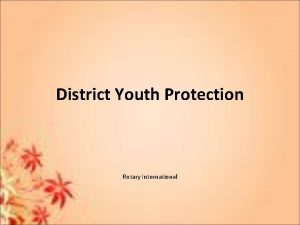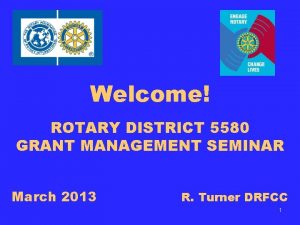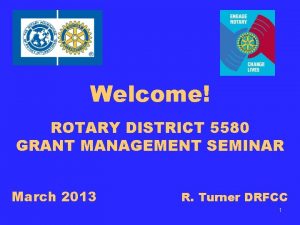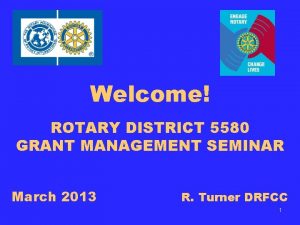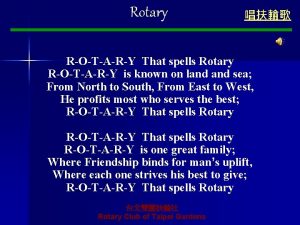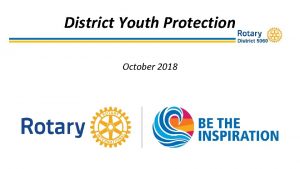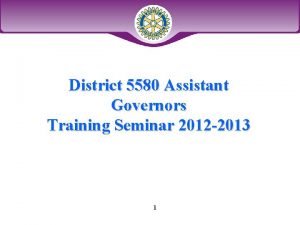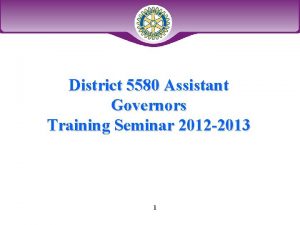TITLE Youth Protection Training Rotary International District 5580
























- Slides: 24

TITLE Youth Protection Training Rotary International District 5580 2019 -20

OVERVIEW & POLICIES OBJECTIVES At the end of this training, you will be able to: • Know how to create and maintain a safe environment for youth; • Recognize, Respond, and Report the different kinds of abuse likely to be experienced by youth; • Know and utilize District 5580’s Youth Protection Policy • Provide basic knowledge and education of youth protection to Rotarians in District 5580 • Know where to report completion of training

ROTARY STATEMENT OF CONDUCT Rotary International strives to create and maintain a safe environment for all youth who participate in Rotary activities. To the best of their ability, Rotarians, Rotarian’s spouses and partners, and other volunteers must safeguard the children and young people they come into contact with and protect them from physical, sexual, and emotional abuse.

TYPES OF ABUSE • • • Neglect Exposure to violence Bullying Emotional abuse Sexual abuse

FIVE IMPORTANT FACTS 1. Most abused children are maltreated by a parent or someone close to them. 2. Children who are abused in one way are often abused in multiple ways (polyvictimization) 3. Maltreated, neglected, and abused children are at a higher risk of being abused again 4. District 5580’s Youth Protection Policy plays an important role in reducing risk. 5. Rotarians can make a difference in the lives of children.

BARRIERS TO ABUSE • Volunteer Training • Certified Volunteers – Significant Interaction – Criminal Background Check - in. Check • • • No One-on-One contact Overnight Accommodations Two-Deep Digital Contact Policy Enforcement Leader Selection – Club and District Youth Protection Officers

WHAT IS BULLYING? Bullying is any unwanted, aggressive behavior by an adult, a youth, or a group that involves an observed or perceived power imbalance and is likely to be repeated multiple times. That imbalance can come from: • Social status • Age • Size • Leadership Position • A sense of entitlement • A feeling of superiority

VERBAL BULLYING • • • Teasing Name-calling Inappropriate sexual comments Taunting Threatening to cause harm

SOCIAL BULLYING • • Leaving someone out on purpose Telling others not to be friends with someone Spreading rumors about someone Embarrassing someone in public.

PHYSICAL BULLYING • • • Hitting/kicking/pinching Spitting Tripping/pushing Taking or breaking someone’s possessions Making offensive or threatening hand gestures • Intimidation

CYBERBULLYING • Harassment using: – Internet – Texting – Social Media • Can include: – Text or instant messages with hostile or degrading comments – Embarrassing digital images – Fictitious online posts intended to humiliate, threaten or coerce.

PREVENTION • • • Create a bully-free, positive environment Set a positive example Know and enforce the youth protection policies Teach everyone about empathy Teach everyone how to look out for one another Teach everyone how to stand up against bullying and be an upstander If you see it, stop it, and report it!

SEXUAL ABUSE • Abuse vs. Harassment • Child sexual abuse is considered a public health crisis by experts and health organizations • 1 out of 4 girls and 1 out of 6 boys experience sexual abuse • The majority of sexual abusers are known to the child and to the parents

TYPES OF SEXUAL ABUSE • Adult-on-Youth – Abusers are often adult family members – Abusers can be neighbors, coaches, teachers, or youth leaders. – Abusers misuse their positions of authority to engage youth in sexually abusive activity. • Youth-on-Youth – Youth abusers are often older siblings, cousins, or family members. – Youth abusers are typically four to five years older, but may be the same age. – Abuse is likely to occur during overnight activities. – Abuse is often disguised as “game playing” by the offender.

GROOMING AND OTHER MANIPULATIVE BEHAVIORS • Works to become close friend of the family • Makes themselves overly accessible to the family • Manipulates youth with gifts and favors • Befriends youth through interests such as video games or sports activities • Gradually desensitizes youth by filming/photographing them or exposing them to pornography, drugs, or alcohol.

GROOMING AND OTHER MANIPULATIVE BEHAVIORS • Progressive invasive touch – Hugs, back rubs, neck massages, wrestling, etc. • Seeks opportunities to undress or shower with youth • Engages youth in sexually themed game play • Manipulates youth through their position of authority • Manipulates youth’s need for love, attention, and affection

RECOGNIZING SIGNS OF ABUSE • Sudden withdrawal from activities the child previously enjoyed • Reluctance to be around a particular individual, especially in the absence of others • Changes in behavior or in school performance, including lower grades • Inability to focus or learning problems with no known cause • Hypervigilance (excessive watchfulness as f anticipating something bad happening) • Overly compliant behavior or an excessive desire to please

RESPONSE TO DISCLOSURE ABOUT ABUSE DON’T • Overreact or panic • Press the child to give specific details • Promise you won’t tell anyone • Shame, blame, or minimize the child’s feelings • Confront the offender • Conduct your own investigation

RESPONSE TO DISCLOSURE ABOUT ABUSE DO: • Let the child know you believe him or her • Show the child you care • Respond in a calm and supportive manner • Tell the child it wasn’t his or her fault • Let the child know you want to help

COMMON EXCUSES FOR NOT REPORTING • • • I’m not sure the youth is telling the truth. I don’t want to ruin someone’s career or life. No one does anything anyway. It could make things worse. I don’t want to get involved or have to testify. People will find out I reported the abuse.

IF YOU ARE UNSURE… A child’s behavior may not be an indicator of abuse. Keep in mind that what you have observed is often only one piece of the puzzle. If unsure, it is always safest to report it.

REPORTING REQUIREMENTS • Rotary volunteers must report any instance of child abuse to local law enforcement. This includes any good faith suspicion or belief that a child is or has been physically or sexually abused. • All suspected incidents of abuse must also be reported to the District Youth Protection Officer.

REPORTING GUIDELINES • • Listen attentively Assure privacy Get the facts, but don’t interrogate Non-judgmental Keep written record Protect the Youth Avoid Gossip and Blame Do not challenge the alleged offender

WHO TO CONTACT • District 5580 Youth Protection Officers – Lynn Hunt (U. S. A. ) • lynnhunt@hugllc. com – Peter Holt-Hindle (Canada) • pholthin@lakeheadu. ca
 5580 sayılı kanun
5580 sayılı kanun Rotary youth exchange länder
Rotary youth exchange länder Central states rotary youth exchange
Central states rotary youth exchange Central states rotary youth exchange
Central states rotary youth exchange Rotary youth exchange south africa
Rotary youth exchange south africa Rotary youth exchange thailand
Rotary youth exchange thailand Rotary grant management seminar
Rotary grant management seminar Prepets
Prepets Rotary district 5390
Rotary district 5390 Rotary district 3330
Rotary district 3330 Rotary 5340
Rotary 5340 Rotary district 7870
Rotary district 7870 Rotary district 7600
Rotary district 7600 Rotary district 6290
Rotary district 6290 Rotary district 1990
Rotary district 1990 Rotary 7750
Rotary 7750 Rotary district 1070 conference 2022
Rotary district 1070 conference 2022 Rotary district 6040
Rotary district 6040 Rotary district 7120
Rotary district 7120 Rotary district 1130
Rotary district 1130 Rotary district 1130
Rotary district 1130 Rotary district 6540
Rotary district 6540 Rotary district 7770
Rotary district 7770 Rotary district 7610
Rotary district 7610 Rotary district 7810
Rotary district 7810
